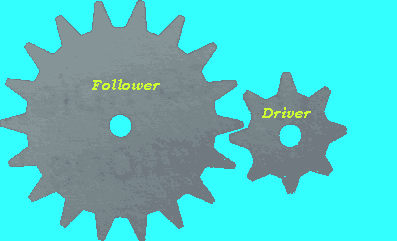Gears have many
uses in our lives. They are used to :
- multiply or reduce speed and force;
- change the direction of motion;
- transmit a force over a distance.
Intermeshing gears are used to transmit motion and force. A series of intermeshing gears is called a gear train. Intermeshing gears turn in opposing directions.
An understanding of some
of the terminology is needed. In a gear train we have a gear known as
the driver and one known as the
follower.
Driver - is the gear that has the force or
motion input.
Follower - is the gear that results in the force or motion
output.

We often talk about a gear ratio. The gear ratio of a gear train is the number of teeth on the follower divided by the number of teeth on the driver. In the gear train above the driver has 18 teeth while the follower has 8 teeth. Therefore the gear ratio is 8/18 or 4/9. For every 4 turns of the driver the follower turns 9 times. This gear train can be used to multiply speed on a bicycle if the follower was connected to a wheel and the driver connected to the paddles.

A simple rule applies.
Low gear ratio = more speed
= less force
High gear ratio= less speed = more force.